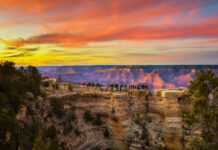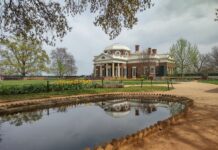Have I morphed into Alice peering through a looking glass in some fantastical dream? Did Lady Gaga and Martha Stewart join forces to create this Technicolor decor before me? Or is this outrageousness really a reality— a magical transformation of the grandest of grande dames, The Greenbrier?
An oversized archway embellished in green and white stripes welcomes me a few steps inside the front door. My eyes feast on furnishings swathed in turquoise, coral, green, pink and lavender in an unconventional mélange of florals, toile and plaids and textures from leather to velvet. A massive mural winds its way up a stairway edged in ornate glossy white mouldings. Velvety blood-red plush carpeting seems to enclose my feet while a shiny black and white marble checkerboard floor pleads for my attention.
 While this is our fifth visit to The Greenbrier, we’ve always had mixed feelings about the resort. The 6,500-acre setting in West Virginia’s Allegheny Mountains, the golf courses and the spa are extraordinary, and the primary reasons we keep returning, but it has always felt a bit stodgy and tired. Recently the regal AAA Five Diamond resort added a new casino, shops and restaurants and plenty of oomph. And now this once-maiden aunt has become a fabulous Auntie Mame.
While this is our fifth visit to The Greenbrier, we’ve always had mixed feelings about the resort. The 6,500-acre setting in West Virginia’s Allegheny Mountains, the golf courses and the spa are extraordinary, and the primary reasons we keep returning, but it has always felt a bit stodgy and tired. Recently the regal AAA Five Diamond resort added a new casino, shops and restaurants and plenty of oomph. And now this once-maiden aunt has become a fabulous Auntie Mame.
For much of The Greenbrier’s 230 years the National Historic Landmark was owned by CSX Corp. During the recession the resort fell on hard times, filed for Chapter 11 and was headed to the auction block when Marriott International made a deal to purchase it. The thought of the landmark becoming part of a chain didn’t feel right to West Virginia businessman Jim Justice so he paid $20.1 million to CSX, a few million more to creditors, $14 million to snap up the Greenbrier Sporting Club (a private golf and residential community on the grounds) and $7.5 million to Marriott “just to go away,” says Justice. Since then he’s invested an additional $125 million in a gutsy transformation. “At the end of the day I’m not driven by profit,” he says. “I don’t have any ambition to pile up gold. I want to do good things. Bringing this grand old lady back to the community is heartwarming.”
Justice owns a thriving coal business as well as Bluestone Farms, which has 50,000 acres in four states and is the largest grain producer on the East Coast, and he’s infusing The Greenbrier with ideas as well as cash. For Monte Carlo-ish élan, he unveiled a snazzy casino and hosted a $2 million star-studded grand opening party. The mood is straight out of a James Bond flick. Vintage movie star photos dot the walls around roulette, blackjack, baccarat, craps and poker tables. Unlike Las Vegas, there isn’t a fake Eiffel Tower or Venetian boat in sight. A dramatically lit clam shell fountain marks the entrance; the Baroque design feature is woven throughout fabrics and carpeting.
 One more un-Vegas touch: it’s quiet. The more than 300 slot machines are silent. And drinks are not on the house. Should you make a killing, a $412,000 emerald, ruby and pearl necklace is on sale in one of the new designer shops mere steps from the casino. We try our luck at roulette, my favorite casino pastime, and attempt to hit the jackpot on the slots but once our $100 gambling budget is gone, a nightcap in our room is a much better bet.
One more un-Vegas touch: it’s quiet. The more than 300 slot machines are silent. And drinks are not on the house. Should you make a killing, a $412,000 emerald, ruby and pearl necklace is on sale in one of the new designer shops mere steps from the casino. We try our luck at roulette, my favorite casino pastime, and attempt to hit the jackpot on the slots but once our $100 gambling budget is gone, a nightcap in our room is a much better bet.
A new eco-friendly, pesticide-free 40-acre Greenbrier Farm grows vegetables that are often served in the resort’s restaurants just hours after they are picked. And, to make getting there half the fun, the Greenbrier Express, a non-stop 17-car luxury train from Washington, D.C., is slated to debut in 2012. Plans call for seven parlor cars accommodating 30 guests each, a club car and two dining cars serving fine cuisine.
“I want to create high-end luxury without an air of snootiness,” says Justice.
Dorothy Draper, a doyenne of interior design from the 1920s to the 1960s, designed The Greenbrier’s grand public lobbies when it reopened in 1948, an event that attracted the Vanderbilts, Astors, Whitneys and the Duke and Duchess of Windsor. Big floral patterns, never-seen-before color combinations and jumbling periods were her trademark. Her designs can still be enjoyed in several public rooms and in the upper lobby, where complimentary tea is served daily at 4:15 p.m., a tradition that began in the 1930s and is not about to change. We join the crowd and wash down blueberry- and tangerine-topped tarts, chocolate brownies and lemon squares with Earl Grey tea served in white china cups. A tuxedoed piano player tickles the ivories as we chat with several guests who are impressed that we live within driving distance of such a grand locale. They’d flown halfway across the country to celebrate a milestone birthday. Lots of people around us appear in a celebratory mood, as if they are commemorating something or other.
The resort boasts 721 rooms and 33 suites in the main building as well as 96 guest and estate houses sprinkled throughout the compound offering one- to five-bedroom cottages and homes. We stay in a one-bedroom cottage with a charming porch and two inviting rocking chairs, a short walk from the hotel. A luxurious but cozy living room with a large flat screen TV, wet bar and working fireplace plus a spacious bedroom, walk-in closet, dressing area and large bathroom create a quiet oasis away from the hubbub of the main building.
 Carleton Varney is the current owner of Dorothy Draper & Co., and his sophisticated yet irreverent style garners design jobs for high-profilers and hotels including The Breakers in Palm Beach and the Grand Hotel on Mackinac Island in Michigan. “Live vividly” is his mantra— and he was the perfect choice to update Draper’s styles and breathe new life into The Greenbrier. Our bedroom looks like it was designed for Alice upon her arrival in Wonderland. The floral wallpaper has more colors than a good dream— pink, yellow, red and green, just for starters. Draperies are turquoise, red and white striped and topped with a cheery floral print valance. White painted furniture edged in robin’s egg blue is accented with a sophisticated Chinese cloisonné lamp and other period pieces. This sounds like a mishmash of colors and styles, but it is one of the happiest rooms I have ever slept in.
Carleton Varney is the current owner of Dorothy Draper & Co., and his sophisticated yet irreverent style garners design jobs for high-profilers and hotels including The Breakers in Palm Beach and the Grand Hotel on Mackinac Island in Michigan. “Live vividly” is his mantra— and he was the perfect choice to update Draper’s styles and breathe new life into The Greenbrier. Our bedroom looks like it was designed for Alice upon her arrival in Wonderland. The floral wallpaper has more colors than a good dream— pink, yellow, red and green, just for starters. Draperies are turquoise, red and white striped and topped with a cheery floral print valance. White painted furniture edged in robin’s egg blue is accented with a sophisticated Chinese cloisonné lamp and other period pieces. This sounds like a mishmash of colors and styles, but it is one of the happiest rooms I have ever slept in.
“I have a love affair with The Greenbrier. It became my lover. I wanted her to look as beautiful and chic and exciting as anyone could ever look,” says Varney. “The hotel retains the one thing America has lost: glamour. An earlier owner wanted to make The Greenbrier look like every other upscale hotel. They standardized some of the rooms and removed wallpapers that had been there for years. We are putting back what was originally there. People go to Tara because they want to experience Tara. They don’t want it to look like just another hotel,” he adds.
The lobby murals were created in France using the original pear woodblocks and printing method that has been used in the same factory for 170 years. (The factory even operates without electric light to simulate lighting conditions in the 19th century.) One depicting life in the United States in the 1830s contains 32 panels and 223 colors and took 1,690 woodblocks to complete. It attracted attention when Jacqueline Kennedy chose it for the White House Diplomatic Reception Room.
With 99 chandeliers and 10 opulent public lobbies to roam, there’s plenty of eye-candy cruising this see-and-be-seen scene. Women are dressed to the nines in spaghetti-strapped numbers and covered in bling. I plop onto a red leather tufted sofa to read the latest issue of Vanity Fair but my attention is diverted to a pair of Christian Louboutin shoes going by, easily recognizable thanks to his trademark red soles. A mom and daughter look like they’ve stepped out of a Ralph Lauren catalog and a young couple snuggles and strolls. There is a buzz about the place that wasn’t felt in our earlier visits, perhaps a result of the new casino and all the recent press attention.
The problem with The Greenbrier of old was not only the stuffy attitude but the lack of less-formal dining choices. That’s changed, too. New restaurants include Prime 44 West, a steakhouse that pays homage to Los Angeles Lakers basketball great and West Virginia native Jerry West. Banquettes in muted earth tones create a warm, clubby ambience. There isn’t a bright color or floral in sight. As with most steakhouses, it’s pricey. A bone-in rib-eye is $65. Want Béarnaise sauce? Add $3. Since I’m not a carnivore, I had the $39 Alaskan Halibut that arrives on the plate with nada. Everything is a la carte— french fries will set you back $10!
 More casual (and less expensive) alternatives include The Forum Wine Bar and Pizzeria where handmade Neapolitan pizzas are baked in coal-fired ovens alongside seafood and pasta specialties. The look is that of a friendly Italian neighborhood trattoria. Venetian blue linens, marble accents plus a 150-bottle wine list invite lingering. Adjacent to the casino, In-Fusion’s sushi and Pacific Rim cuisine is served in a dimly lit setting surrounded by a collection of eye-catching tea canisters. Draper’s is a pretty pink tribute to the restaurant’s namesake and hums with the same energy as a New York bistro. Pink and green garden scenes embellish walls, place mats and deeply tufted booths. Expect pink water glasses and tabletops and even pink candies behind the counter in this casual dining option. Red carpeting is splashed with— you guessed it— pink roses.
More casual (and less expensive) alternatives include The Forum Wine Bar and Pizzeria where handmade Neapolitan pizzas are baked in coal-fired ovens alongside seafood and pasta specialties. The look is that of a friendly Italian neighborhood trattoria. Venetian blue linens, marble accents plus a 150-bottle wine list invite lingering. Adjacent to the casino, In-Fusion’s sushi and Pacific Rim cuisine is served in a dimly lit setting surrounded by a collection of eye-catching tea canisters. Draper’s is a pretty pink tribute to the restaurant’s namesake and hums with the same energy as a New York bistro. Pink and green garden scenes embellish walls, place mats and deeply tufted booths. Expect pink water glasses and tabletops and even pink candies behind the counter in this casual dining option. Red carpeting is splashed with— you guessed it— pink roses.
While The Greenbrier is touting what’s new, the biggest asset is its past. In the 18th century the sulphur springs were thought to be a medicinal miracle. What began as a collection of tents evolved into a luxury hotel and spa catering to the royal and rich. In World War II it was an Army hospital and during the Cold War it housed a top-secret bunker for members of Congress in case of an attack (the bunker is now open for tours). Famous Greenbrier guests include 26 presidents. And it was the summer White House for 14 of them.
More than 50 activities including falconry, white-water rafting, mountain biking, horseback riding and fly fishing, croquet and billiards are offered. There’s even a bowling alley! But our visit is all about golf and the spa.
The resort recently hosted the Greenbrier Classic, the PGA’s newest FedEx Cup Series event on The Old White Course, one of three championship golf courses on the property. Velvety greens resemble roller coasters and deep bunkers make us think of Scotland. The weather helped— it was cold and blustery when we played. Tom Watson, winner of 39 PGA Tour events, is the resort’s golf professional emeritus, and the list of pros who have walked the fairways reads like a who’s who in golf.
Sybaritic spa pleasures are available for most family members, including mini-manicures and pedicures for kids ages 6 and up. Because of the mineral springs, several treatments include sulphur soaks— too odorous for me— but there are 40 other choices. I opt for a deep tissue massage by Jenny, the fifth-generation in her family to work at The Greenbrier. Many of the resort’s employees are descendants of former staff.
After three heavenly days at The Greenbrier, we find it difficult to re-enter reality, which seems exactly right. “The last thing Dorothy Draper ever wanted was for you to feel like you were home,” says Varney. “She wanted you to remember the fantasy.”
The Greenbrier
300 W. Main St., White Sulphur Springs, W.Va.,
800-624-6070, http://www.greenbrier.com
(About a five-hour drive from Baltimore via 81 South to 64 West.)




